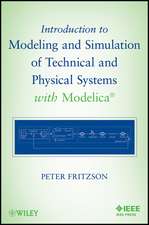Viability Theory: New Directions
Autor Jean-Pierre Aubin, Alexandre M. Bayen, Patrick Saint-Pierreen Limba Engleză Hardback – 13 iul 2011
| Toate formatele și edițiile | Preț | Express |
|---|---|---|
| Paperback (1) | 1677.54 lei 6-8 săpt. | |
| Springer Berlin, Heidelberg – 13 iul 2011 | 1677.54 lei 6-8 săpt. | |
| Hardback (1) | 1679.25 lei 6-8 săpt. | |
| Springer Berlin, Heidelberg – 13 iul 2011 | 1679.25 lei 6-8 săpt. |
Preț: 1679.25 lei
Preț vechi: 2047.87 lei
-18% Nou
Puncte Express: 2519
Preț estimativ în valută:
321.36€ • 348.95$ • 269.94£
321.36€ • 348.95$ • 269.94£
Carte tipărită la comandă
Livrare economică 23 aprilie-07 mai
Preluare comenzi: 021 569.72.76
Specificații
ISBN-13: 9783642166839
ISBN-10: 3642166830
Pagini: 820
Ilustrații: XXI, 803 p.
Dimensiuni: 155 x 235 x 51 mm
Greutate: 1.19 kg
Ediția:2nd ed. 2011
Editura: Springer Berlin, Heidelberg
Colecția Springer
Locul publicării:Berlin, Heidelberg, Germany
ISBN-10: 3642166830
Pagini: 820
Ilustrații: XXI, 803 p.
Dimensiuni: 155 x 235 x 51 mm
Greutate: 1.19 kg
Ediția:2nd ed. 2011
Editura: Springer Berlin, Heidelberg
Colecția Springer
Locul publicării:Berlin, Heidelberg, Germany
Public țintă
ResearchCuprins
Overview and Organization.- Viability Kernels and Examples: Viability and Capturability.- Viability Problems in Robotics.- Viability and Dynamic Intertemporal Optimality.- Avoiding Skylla and Charybdis.- Inertia Functions, Viability Oscillators and Hysteresis.- Management of Renewable Resources.- Mathematical Properties of Viability Kernels: Connection Basins.- Local and Asymptotic Properties of Equilibria.- Viability and Capturability Properties of Evolutionary Systems.- Regulation of Control Systems.- Restoring Viability.- First-Order Partial Differential Equations: Viability Solutions to Hamilton-Jacobi Equations.- Regulation of Traffic.- Illustrations in Finance and Economics.- Viability Solutions to Conservation Laws.- Viability Solutions to Hamilton-Jacobi-Bellman Equations.- Appendices: Set-Valued Analysis at a Glance.- Convergence and Viability Theorems.
Recenzii
From the reviews of the second edition:
“This comprehensive book of more than 800 pages has many purposes. … who want to learn the theory and may be interested in its research potential will also be quite happy with the book. … authors have made their book very lively by providing quotations and pictures of famous scientists and writers … . great reference for many types of readers: mathematicians, application-oriented users, and even science historians interested in the evolution of science and its cultural aspects. It will certainly motivate young scientists … .” (Alain Bensoussan, Mathematical Reviews, January, 2011)
“This is the second edition of the well-known monograph. It is devoted to the viability theory and algorithmic methods for investigation of the adaptation of complex systems with uncertainties. Such systems can be found in biology, economics, environmental sciences, final markets, control theory, robotics etc. … The monograph contains many unpublished results and is addressed to graduate students and scientists.” (Tadeusz Kaczorek, Zentralblatt MATH, Vol. 1238, 2012)
“This comprehensive book of more than 800 pages has many purposes. … who want to learn the theory and may be interested in its research potential will also be quite happy with the book. … authors have made their book very lively by providing quotations and pictures of famous scientists and writers … . great reference for many types of readers: mathematicians, application-oriented users, and even science historians interested in the evolution of science and its cultural aspects. It will certainly motivate young scientists … .” (Alain Bensoussan, Mathematical Reviews, January, 2011)
“This is the second edition of the well-known monograph. It is devoted to the viability theory and algorithmic methods for investigation of the adaptation of complex systems with uncertainties. Such systems can be found in biology, economics, environmental sciences, final markets, control theory, robotics etc. … The monograph contains many unpublished results and is addressed to graduate students and scientists.” (Tadeusz Kaczorek, Zentralblatt MATH, Vol. 1238, 2012)
Textul de pe ultima copertă
Viability theory designs and develops mathematical and algorithmic methods for investigating the adaptation to viability constraints of evolutions governed by complex systems under uncertainty that are found in many domains involving living beings, from biological evolution to economics, from environmental sciences to financial markets, from control theory and robotics to cognitive sciences. It involves interdisciplinary investigations spanning fields that have traditionally developed in isolation. The purpose of this book is to present an initiation to applications of viability theory, explaining and motivating the main concepts and illustrating them with numerous numerical examples taken from various fields.
Caracteristici
New groundbreaking results in viability theory Interdisciplinary research and applications to biology, cognitive sciences, economics, finance, environmental sciences, control theory, and robotics Initiation to the main concepts and illustration by numerical examples from various fields Includes supplementary material: sn.pub/extras












